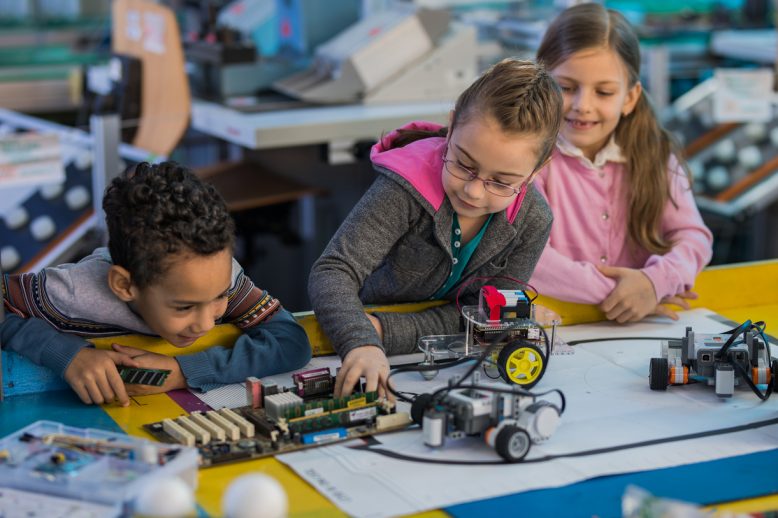Quality STEM education is necessary for molding the upcoming generation of scholars. This discipline influences virtually every industry. While jobs are abundant, they often go unfilled.
Educators can combat this problem by teaching students the value of STEM. However, many of them encounter funding issues. Schools don't always have adequate budgets to support engineering and technology programs, especially when they require expensive tools.

Educating students is difficult without monetary support. Schools are using creative ideas for funding STEM programs and paying teachers. If your institution needs new ideas on bringing in more money, read about the six ideas below.
1. Donations
Hold fundraisers and accept donations from local businesses and citizens. The items students sell don't have to relate to STEM, but you might see more success if there's a connection. VEX Robotics, for example, offers HEXBUG packages schools can purchase and sell for $5 or more. These gadgets are waterproof and can swim through liquids, making them fun toys for any age.
Other ideas include a bake sale, talent show or science fair with a small admission fee. Talent and science events allow students to showcase their skills and earn money for a worthy cause.
2. Grants
Apply for several grants if you haven't already. Federal awards are abundant, and many businesses offer private grants as part of give-back programs. Non-STEM companies, like Kelloggs and Coca-Cola, also extend monetary support. Check the criteria for each award you look into to ensure your school fits the bill.
The National Science Foundation, for example, offers grants to schools across 24 states and the U.S. Virgin Islands. This money goes to both students and faculty to make studying and teaching STEM accessible. As of now, they offer aid for countless STEM subjects, including archaeology, astronomy and ecology.
3. Local Businesses
Communicating with local businesses is an excellent avenue for procuring funds — especially if they're committed to STEM. Reach out to nearby companies and inform them of your school's program. They're likely to show support when they see there's a pressing need to promote education for young students. PeoplesBank, for example, recently contributed $150,000 to 13 organizations specializing in preschool education and early learning.
Consider inviting employees from your chosen company to speak at a science fair or another STEM event. They'll receive a welcome introduction and get familiar with who they're donating to.
4. Negotiate Deals
If you want to purchase devices for your classroom but can't afford to buy them in bulk, contact the manufacturer directly and negotiate. Prepare a solid pitch that describes your classroom's needs and offers a few flexible prices. Providing numbers and goals will show your dedication to improving student learning the affordable way.
You can search for discounts from manufacturers and retailers. Educational supply sites offer lower pricing for institutions that struggle to afford learning tools. You can also find coupons and specials by scouting search engines.
5. State Department of Education
Look to your state's Department of Education (DOE) to provide monetary support. The federal DOE recently awarded $78 million to STEM initiatives as part of their Education and Innovation Research program. Look up opportunities in your municipality and see if your school fits the criteria.
Your local DOE has likely established standards they expect schools to adhere to concerning STEM education. Ensure your school's program fits these guidelines to make it easier to obtain funding.
6. Utility Management
One unexpected way to obtain funds for STEM programs is to rehaul the school's utilities. Much of the money within your school's budget likely goes toward energy bills. The lights stay on all day, every day. Plus, we hook up dozens of computers and projectors to outlets. Decreasing the school's energy consumption can allocate money for administrators to funnel into STEM. A little goes a long way.
Talk to administrators about making the switch to renewable energy. One study revealed that if schools utilize all viable space for solar panels, they can meet up to 75% of their energy needs and deliver $4 billion in savings. Institutions can also save with dimmer-compatible LED lightbulbs, energy-saving appliances, light timers and programmable thermostats.
High-Quality STEM Creates Educated Students
Create a better future for tomorrow's learners by supporting academic passions. When you fund STEM programs, you encourage student engagement and interest. Help students reach their full potential by investing in education.

Discover more about STEM Education with RobotLAB!
Check our products page, and our learning platform Engage!K12 that offer a wide range of lessons for students and teachers! No robotics experience required.
 Kayla Matthews is a robotics and EdTech writer whose work has appeared on The Robot Report, Information Age, Learning Liftoff and Robotics Business Review. To read more from Kayla, please visit her tech blog.
Kayla Matthews is a robotics and EdTech writer whose work has appeared on The Robot Report, Information Age, Learning Liftoff and Robotics Business Review. To read more from Kayla, please visit her tech blog.



